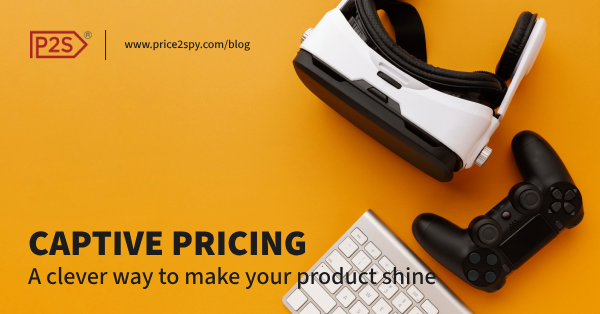
Boost Revenue with Smarter Captive Pricing
Captive pricing offers a clever way to make your product shine while unlocking additional revenue from complementary items. When done right, it feels like a win for everyone. Customers enjoy great deals upfront and appreciate the value of accessories that enhance their experience. In this post, we explain the strategy with real examples, data insights, and a few pro tips to help you elevate your pricing game.
What Is Captive Product Pricing?
Captive pricing, also called captive product pricing, is a strategy where a core product is offered at an appealing price, while essential accessories come at a premium. That’s where the smart part comes in. Customers invest in a main item and naturally need accessories, creating repeat business and solid profits.
The logic behind captive pricing: customers buy the main product at an attractive price, but to use it fully, they need additional items that are sold separately. These additional products, called captive products, are often exclusive to the brand and priced at a higher margin.
Think of it like this:
You sell the core product to get the customer in.
Then you continue earning as they buy related products they can’t do without.
These add-ons are not optional—they’re essential for the product to work or perform at its best. That’s what makes the strategy so powerful.
Why It’s So Effective?
- Lower barrier to entry – Competitive prices attract more first-time buyers
- Enhanced loyalty – Accessories from your brand ensure a consistent, high-quality experience
- Reliable revenue – Customers who commit to your ecosystem tend to return regularly
Captive Pricing Real‑Life Examples
Have you ever considered yourself as a captive product? Yes, you can also be a captive product, and believe it or not, you have likely been in such situations many times.
For example, when you are waiting for the flight, the lunch you pay for at the airport is more expensive than the one you could have outside the airport. It is interesting to think this way, but let’s bring focus back on captive product pricing. Surely, you can think of many everyday products that are sold as core and captive products. Here are several most common examples:
Printers and Ink Cartridges
You can pick up a brand‑name printer for under €100, but replacement cartridges often cost just as much or more. Cartridges make up a large portion of the total profit.
Coffee Machines and Pods
Single‑serve brewers sell for €100–€200, while pods may cost €0.80–€1.20 each. A household spending two boxes per month ends up spending about €300–€400 annually on pods alone.
Razors and Blades
You buy the handle once and then invest in refill blades. The blades are where margins really grow.
Gaming Consoles and Games
Console manufacturers often break even on hardware. Games, online services, and themed controllers deliver ongoing income.
SaaS Freemium Models
A basic version of the software is free or low‑cost. Paid upgrades for advanced features bring in predictable monthly or yearly revenue.
Benefits & Risks of Captive Pricing
These real-life examples highlight how captive pricing relies on selling a main product, often at a competitive price, alongside essential add-ons that drive ongoing revenue. What makes this model effective is that these extras aren’t optional; they’re necessary for the product to function or deliver its full value. When done well, captive pricing encourages repeat purchases and builds brand loyalty. Still, like any strategy, it comes with both benefits and challenges to consider.
Pros
- High customer lifetime value, driven by repeat accessible purchases
- Loyalty lock-in makes switching unattractive when accessories only fit one brand
- Predictable revenue flows – you can forecast accessory sales with high accuracy
Cons
- Customer frustration if prices feel unfair erodes trust
- Regulatory risks: hidden add-on costs can trigger consumer protection issues
- Market risks: if accessories are overpriced, users may switch or seek third-party alternatives
Keys to Ethical & Effective Captive Pricing
While captive pricing offers clear advantages, like stronger customer retention and recurring revenue, it’s not without its challenges. That’s why a thoughtful approach is essential. With the right balance between value and transparency, this strategy can be effective across various industries. Here are some practical tips to help you implement captive pricing effectively:
- Transparent pricing: State which add-ons are essential and their costs
- Balanced ecosystem: Keep accessory pricing reasonable to avoid alienating customers
- Focus on value: Offer unique benefits, better quality, or convenience to justify the cost (e.g., premium ink output, exclusive coffee blends, curated game libraries)
- Support with data: Utilize pricing intelligence tools to monitor competitors’ product prices, market rates, and adjust proactively
Subscribe to our newsletter!
Latest pricing news, eCommerce updates and more!
Once you’ve understood how to apply it, it’s also useful to see how captive pricing stacks up against other common strategies. We’ve chosen to compare it with bundle pricing and freemium pricing because all three aim to increase long-term customer value, but in different ways. Bundle pricing focuses on offering a complete package upfront, while freemium models lower the entry barrier and monetize over time through upgrades. Each approach has its strengths, and understanding the differences can help you choose the right fit for your business.
| Strategy | Approach to Core Price | Where Profit Comes From | Best For |
| Captive Product | Low entry price | Accessories | Printers, pods, blades |
| Bundle Pricing | Combined deal price | Overall packaged value | Holiday deals, starter kits |
| Freemium / Subscription | Freemium or ultra-low price | Upgrades and premium plans | SaaS, digital tools |
Final Thoughts
Captive product pricing is a strategy that rewards both businesses and customers when executed thoughtfully. Your brand builds a loyal customer base while generating consistent revenue through accessories or add‑ons. Clear value, smart accessory pricing, and continuous data-driven adjustment are the keys to success.




